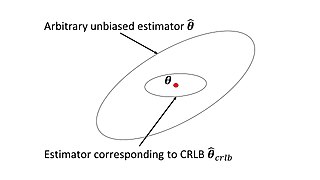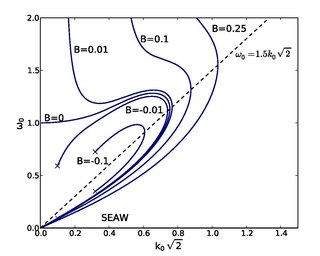
The uncertainty principle, also known as Heisenberg's indeterminacy principle, is a fundamental concept in quantum mechanics. It states that there is a limit to the precision with which certain pairs of physical properties, such as position and momentum, can be simultaneously known. In other words, the more accurately one property is measured, the less accurately the other property can be known.
In linear algebra, an invertible complex square matrix U is unitary if its matrix inverse U−1 equals its conjugate transpose U*, that is, if
In database theory, relational algebra is a theory that uses algebraic structures for modeling data and defining queries on it with well founded semantics. The theory was introduced by Edgar F. Codd.

In mathematics, a Green's function is the impulse response of an inhomogeneous linear differential operator defined on a domain with specified initial conditions or boundary conditions.

In estimation theory and statistics, the Cramér–Rao bound (CRB) relates to estimation of a deterministic parameter. The result is named in honor of Harald Cramér and Calyampudi Radhakrishna Rao, but has also been derived independently by Maurice Fréchet, Georges Darmois, and by Alexander Aitken and Harold Silverstone. It is also known as Fréchet-Cramér–Rao or Fréchet-Darmois-Cramér-Rao lower bound. It states that the precision of any unbiased estimator is at most the Fisher information; or (equivalently) the reciprocal of the Fisher information is a lower bound on its variance.
In computability theory Post's theorem, named after Emil Post, describes the connection between the arithmetical hierarchy and the Turing degrees.
In differential topology, the jet bundle is a certain construction that makes a new smooth fiber bundle out of a given smooth fiber bundle. It makes it possible to write differential equations on sections of a fiber bundle in an invariant form. Jets may also be seen as the coordinate free versions of Taylor expansions.
Independence-friendly logic is an extension of classical first-order logic (FOL) by means of slashed quantifiers of the form and , where is a finite set of variables. The intended reading of is "there is a which is functionally independent from the variables in ". IF logic allows one to express more general patterns of dependence between variables than those which are implicit in first-order logic. This greater level of generality leads to an actual increase in expressive power; the set of IF sentences can characterize the same classes of structures as existential second-order logic.
In theoretical physics, the Wess–Zumino model has become the first known example of an interacting four-dimensional quantum field theory with linearly realised supersymmetry. In 1974, Julius Wess and Bruno Zumino studied, using modern terminology, dynamics of a single chiral superfield whose cubic superpotential leads to a renormalizable theory. It is a special case of 4D N = 1 global supersymmetry.
In mathematics, the spectral theory of ordinary differential equations is the part of spectral theory concerned with the determination of the spectrum and eigenfunction expansion associated with a linear ordinary differential equation. In his dissertation, Hermann Weyl generalized the classical Sturm–Liouville theory on a finite closed interval to second order differential operators with singularities at the endpoints of the interval, possibly semi-infinite or infinite. Unlike the classical case, the spectrum may no longer consist of just a countable set of eigenvalues, but may also contain a continuous part. In this case the eigenfunction expansion involves an integral over the continuous part with respect to a spectral measure, given by the Titchmarsh–Kodaira formula. The theory was put in its final simplified form for singular differential equations of even degree by Kodaira and others, using von Neumann's spectral theorem. It has had important applications in quantum mechanics, operator theory and harmonic analysis on semisimple Lie groups.
In linear algebra, particularly projective geometry, a semilinear map between vector spaces V and W over a field K is a function that is a linear map "up to a twist", hence semi-linear, where "twist" means "field automorphism of K". Explicitly, it is a function T : V → W that is:
In set theory and mathematical logic, the Lévy hierarchy, introduced by Azriel Lévy in 1965, is a hierarchy of formulas in the formal language of the Zermelo–Fraenkel set theory, which is typically called just the language of set theory. This is analogous to the arithmetical hierarchy, which provides a similar classification for sentences of the language of arithmetic.
Dependence logic is a logical formalism, created by Jouko Väänänen, which adds dependence atoms to the language of first-order logic. A dependence atom is an expression of the form , where are terms, and corresponds to the statement that the value of is functionally dependent on the values of .
In mathematics, a determinantal point process is a stochastic point process, the probability distribution of which is characterized as a determinant of some function. They are suited for modelling global negative correlations, and for efficient algorithms of sampling, marginalization, conditioning, and other inference tasks. Such processes arise as important tools in random matrix theory, combinatorics, physics, machine learning, and wireless network modeling.

Symmetries in quantum mechanics describe features of spacetime and particles which are unchanged under some transformation, in the context of quantum mechanics, relativistic quantum mechanics and quantum field theory, and with applications in the mathematical formulation of the standard model and condensed matter physics. In general, symmetry in physics, invariance, and conservation laws, are fundamentally important constraints for formulating physical theories and models. In practice, they are powerful methods for solving problems and predicting what can happen. While conservation laws do not always give the answer to the problem directly, they form the correct constraints and the first steps to solving a multitude of problems. In application, understanding symmetries can also provide insights on the eigenstates that can be expected. For example, the existence of degenerate states can be inferred by the presence of non commuting symmetry operators or that the non degenerate states are also eigenvectors of symmetry operators.
Pure inductive logic (PIL) is the area of mathematical logic concerned with the philosophical and mathematical foundations of probabilistic inductive reasoning. It combines classical predicate logic and probability theory. Probability values are assigned to sentences of a first-order relational language to represent degrees of belief that should be held by a rational agent. Conditional probability values represent degrees of belief based on the assumption of some received evidence.
In first-order arithmetic, the induction principles, bounding principles, and least number principles are three related families of first-order principles, which may or may not hold in nonstandard models of arithmetic. These principles are often used in reverse mathematics to calibrate the axiomatic strength of theorems.
In theoretical physics, more specifically in quantum field theory and supersymmetry, supersymmetric Yang–Mills, also known as super Yang–Mills and abbreviated to SYM, is a supersymmetric generalization of Yang–Mills theory, which is a gauge theory that plays an important part in the mathematical formulation of forces in particle physics. It is a special case of 4D N = 1 global supersymmetry.
In game theory, a Bayes correlated equilibrium is a solution concept for static games of incomplete information. It is both a generalization of the correlated equilibrium perfect information solution concept to bayesian games, and also a broader solution concept than the usual Bayesian Nash equilibrium thereof. Additionally, it can be seen as a generalized multi-player solution of the Bayesian persuasion information design problem.

A nonlinear dispersion relation (NDR) is a dispersion relation that assigns the correct phase velocity to a nonlinear wave structure. As an example of how diverse and intricate the underlying description can be, we deal with plane electrostatic wave structures which propagate with in a collisionless plasma. Such structures are ubiquitous, for example in the magnetosphere of the Earth, in fusion reactors, or in a laboratory setting. Correct means that this must be done according to the governing equations, in this case the Vlasov-Poisson system, and the conditions prevailing in the plasma during the wave formation process. This means that special attention must be paid to the particle trapping processes acting on the resonant electrons and ions, which requires phase space analyses. Since the latter is stochastic, transient and rather filamentary in nature, the entire dynamic trapping process eludes mathematical treatment, so that it can be adequately taken into account “only” in the asymptotic, quiet regime of wave generation, when the structure is close to equilibrium.




















